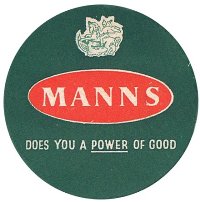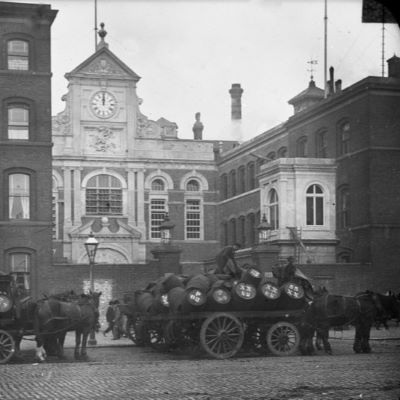Closed brewery
Albion Brewery, Whitechapel Road E1 1BU (Tower Hamlets)
First sold beer: by 1673, perhaps earlier
Ceased brewing: 1979
An inn stood on the northwest corner of the junction of Whitechapel Road and Cambridge Heath Road since before 1654, with an attached brewhouse since at least 1673. It was known as the Blind Beggar after a legendary figure who supposedly begged on the site, featured in the popular ballad ‘The Blind Beggar of Bethnal Green’, known since the early 17th century. In the ballad, the beggar turns out secretly to be very rich, and in some versions is identified with Henry de Montfort, a young nobleman who was killed in 1265 during the Second Barons’ War. In these versions, Henry survived but was blinded and became a beggar.
This was long a busy and important junction on the old Roman road from London to Colchester, which becomes known as Mile End Road east of here, as the crossing was a mile (1.6 km) from Aldgate where the road left the City of London. During the 18th century the road was ‘turnpiked’ (improved by a trust which recouped its investment by imposing tolls on road users) and a toll gate installed at the junction.
In 1807, the Blind Beggar’s owner Richard Ivory enlarged and improved the brewhouse with the intention of leasing it to a third party, and in 1809 John Hoffman is listed as brewing at what was now known as the Albion Brewery. Hoffman got into financial difficulties and in 1819 the business was sold to Philip Blake and his junior partner James Mann.
Blake and Mann already owned a brewery, the Strand Bridge Brewery in College Street, Lambeth, on the riverside by Kings Arms Stairs, in what’s now Jubilee Gardens just north of the London Eye (SE1 7PB). This had been established around 1783 as a porter brewery by the Martineau family, and the firm was known as Martineau & Bland when it merged with Whitbread in 1812. Brewing ceased at the Lambeth site, but was revived when Blake and Mann bought it in 1816. Following their acquisition of the Albion, the partners concentrated their activities there, and closed the Lambeth site in 1821.
Blake retired in 1826 and Mann ran the Albion on his own for 20 years. In 1846 he financed expansion by going into partnership with Robert Crossman and Thomas Paulin, both of whom had previously worked at what became the Stag brewery in Mortlake. The business was known as Mann Crossman & Paulin from 1847.
By 1850, the Albion was producing almost 100,000 hl a year, supplying 500 pubs, mainly with a porter known as Entire. The brewery was rebuilt in 1863 and expanded onto adjacent sites, including former almshouses and a workhouse, becoming the most advanced brewery of that time, with a capacity of 410,000 hl a year. Stables on the east side of Cambridge Heath Road included an automatic facility for filling 150 nosebags at a time with metal tubes from a store above.
Manns became one of the London breweries to add capacity in Burton upon Trent, opening a second Albion Brewery on the outskirts of the town at Shobnall in 1875. In 1898, by which time the firm was producing over 800,000 hl a year, the Burton site was sold to a local brewer, Marston’s, founded at the Horninglow Brewery in the town centre in 1834.
By the end of the 19th century, Manns was noted for its investment in bottled beer. Having outgrown the original bottling store on the former workhouse site, the brewery added a much larger bottling plant surmounted by a water tower a short distance away on the south side of Whitechapel Road, off Sidney Street. In 1892, it became one of the first brewers to capture carbon dioxide during fermentation, using it to carbonate bottled beers and selling it to other brewers for the same purpose.
In 1899, or possibly 1902, head brewer Thomas Wells Thorpe created a new style of bottled brown ale which was relatively low in alcohol (around 3.5%) and described at the time as ‘the sweetest beer in London’. In subsequent decades Manns Brown became the brewery’s best-known brand. Other noted bottled brands included Cream Label Stout and Rustic Ale, a pale ale.
In January 1911, the bottling plant played a role in the notorious Sidney Street Siege, an attempt by police to arrest two Latvian immigrants, assumed to be anarchists and alleged to have taken part in an attempted robbery at a Houndsditch jewellers the previous month in which three policemen had been shot dead. The two men were traced to a terraced house at 100 Sidney Street and a firefight ensued. An injured policeman was first taken to the Manns plant before going to the Royal London Hospital.
The army were called, and Winston Churchill, then responsible for the Metropolitan Police in his role of home secretary, attended. Army snipers took positions on the bottling plant’s water tower. For reasons never explained, a fire broke out inside the house but the police and Churchill stopped the fire brigade from attempting to extinguish it, and both suspects and a fireman died. The siege was sensationally reported in the media in terms of the supposed menace of foreign and likely Jewish anarchists and revolutionaries in the East End.
The company absorbed a number of other breweries in the 1920s and 1930s, including four in Greater London: Michell Goodman Young & Co of the Stamford Hill Brewery, Stoke Newington (founded by 1775, bought and closed 1919); Brandon’s Brewery, Putney (founded c1800, bought 1920, ceased brewing 1949 though continued in use for bottling for some time); Best’s Brewery, Clapham (founded by 1831, bought and closed 1924); and the Hornchurch Brewery Co (founded 1789, bought 1925, brewing ceased 1929).
Manns merged with Watney in 1958 to form Watney Mann, and was bought in turn by the Grand Metropolitan group in 1974, becoming Watney Mann Truman later that year. The Albion was closed in 1979, by which time it was making only bottled and keg beer, principally bottled Manns Brown.
Where are they now?
Watney transferred production of Manns Brown to its Stag brewery when it closed the Whitechapel site. When its parent Grand Metropolitan withdrew from brewing in 1991, the brand was sold to Refresh UK, a company set up by Watney managers who continued to brew it at another former subsidiary, Ushers of Trowbridge. This closed in 2000 and Refresh UK eventually became part of Marston’s, with Manns transferred to another of its brewing sites, Banks’s in Wolverhampton, where it remains in production today at 2.8% ABV, now part of the Carlsberg portfolio.
Brewing briefly returned to the vicinity in 2013 when a small kit was installed in the cellar of the White Hart pub, opposite the Blind Beggar on the northeast corner of the junction. It traded as One Mile End after its address. The brewery relocated to a larger site in Tottenham in 2016 and subsequently closed.
Things to see
The main gates and frontage, now Grade II-listed, still stand on Whitechapel Road, just short of the junction (333 Whitechapel Road E1 1BU), looking much as they did when the brewery was in operation. The decorative iron arch over the main gate still bears the name Mann, Crossman & Paulin, and the imposing yellow brick building behind is surmounted by a decorated pediment with a clock and flagpole. It was subsequently used as offices, though converted to flats around 1995.
The main brewery site behind this has been demolished, with much of it now occupied by a supermarket. Some of it was excavated and redeveloped again in the late 2010s and early 2020s during the construction of the Elizabeth Line through Whitechapel station, unexpectedly uncovering the brewery’s artesian well.
The Blind Beggar was rebuilt in 1894 and became notorious as the place where gangster Ronnie Kray murdered George Cornell in 1966. The building, still bearing its 1980s Watney branding, remains in use as a pub, though has a modern interior and is of no great beer interest.
Another attractive heritage building that once formed part of the site is the Brewery Engineer’s House, a little further east on the other side of the junction (27a Mile End Road E1 4TP). This is a flamboyant Edwardian neo-Baroque house built in 1905 and now Grade II-listed, though its unusual mansard and gable were added in the 1980s. The Grade I-listed 17th century Trinity Almshouses next door are unconnected to the brewery but nonetheless contribute to the interesting streetscape.
The famous stables were behind the Engineer’s House, accessed from around the corner in Cambridge Heath Road: the driveway is still there but the stables were badly bombed in the 1940s and demolished soon afterwards.
The bottling plant has also been demolished: the Silk District, an early 2020s mixed use development, now stands on the site. The besieged terrace in Sidney Street was replaced by social housing in the 1960s.
Marston’s still operates the Albion brewery in Burton, now as part of Carlsberg, and has been known to offer brewery tours (Shobnall Road, Burton upon Trent DE14 2BD). For many years the building housed the only remaining working traditional Burton Union fermentation sets in the UK. These were decommissioned early in 2024 though at least one of them is being moved to Thornbridge in Bakewell, Derbyshire.
Updated 16 May 2024.
More London breweries
Closed London breweries







Leave a Reply